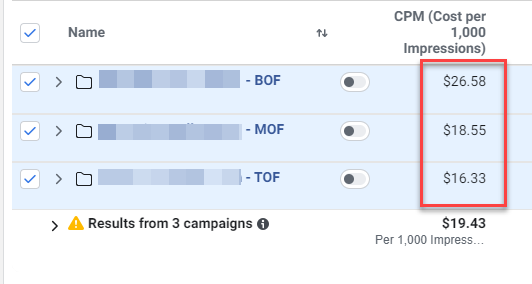If there’s one thing online marketing has, it’s a lot of acronyms!
Three, in particular, are used a lot in media buying:
- CPM.
- eCPM.
- RPM.
In self-serve paid media platforms like Google Ads or Facebook Ads, most brands and advertisers think of things in terms of PPC, or pay per click: when a user clicks, the advertiser pays.
It doesn’t rely on the CPM model at its forefront, so terms like CPM or RPM might be confusing at first to advertisers who have only done PPC.
These measurements are more commonly used in programmatic ad buying, but they can also help you “equalize” costs to understand what one channel costs relative to another.
To demystify the acronyms and where they fit into the paid media ecosystem, let’s look at each type, and some examples.
One thing to keep in mind with media money is there are two parties involved:
- The advertiser who is making the media purchase.
- The publishers, which are the websites actually showing the ads.
The acronyms that float around apply to these two specific parties.
What Is CPM?
CPM stands for “cost per thousand impressions.”
It’s the dollar amount an advertiser pays to show their ad 1,000 times.
Note this is an advertiser metric, not a publisher one.
In other words, it’s what an advertiser pays for their ad to show.
It’s not what a website earns when they show the ad 1,000 times. (That’s RPM, which we will cover shortly.)
Typically, the more valuable the site traffic is, the higher the CPM will be.
Calculating CPM follows a simple formula:

This breaks down the cost for a single impression, and then multiplies it by 1,000 to get the CPM.
Let’s look at an example.
Say you contract for a programmatic display buy, and you have $30,000 to spend on the campaign.
You run estimates on how many impressions it will get you, and it comes back at 2,500,000 impressions.

Based on the calculation, you’d be paying a $12 CPM.
CPM can also help you understand the relative value of audiences within a platform like Facebook when you view them next to each other.
Here’s an example of a Top of Funnel (so, wider targeting), Middle of Funnel (warm audience targeting), and Bottom of Funnel (hot prospects/site visitors) CPMs.

Notice how the CPM is lower for the broader targeting vs. the bottom of funnel users?
The bottom-funnel users are not only a smaller pool a brand is trying to reach, but they’re also likely to buy – and all the other advertisers are probably trying to target those same people.
The supply is low, and demand is high, and you see prices escalate accordingly.
What Is eCPM?
You may now be wondering: what happens if I do a large media buy that uses a bunch of different bidding models?
How would I understand the CPM relative to my overall goals?
This is where eCPM comes in.
Let’s say you have some CPM buys, but you also have some of your media buy going towards CPA or CPC-based costs.
Because the optimizations are different for each type, there may not seem to be a common denominator to understand your all-up cost.
But there is!
eCPM or “effective CPM,” helps achieve this.
It converts non-CPM buying into a CPM calculation so you can understand what you’re “effectively” (see?) paying in CPM.
The calculation is the same, but the “e” reference denotes it’s not necessarily a fixed price model like a straight CPM buy through a publisher would be.
So let’s say you had 85,000 impressions in a Google Ads PPC campaign, and you paid $20,000. Using the same calculation as above, you would get a CPM of $23.53.
eCPM will frequently be higher than fixed CPM in more direct-response channels like CPC or CPA campaigns because it’s a higher-value action you’re going after from users.
What Is RPM?
RPM stands for “revenue per thousand impressions.”
Unlike CPM, RPM is a publisher-side metric.
It’s a measurement of how much a publisher (or website) is earning for every 1,000 times it shows an ad.
Essentially, it’s the rate at which they’re making money – so it’s a very important metric!
The equation will look very familiar since all you’re doing is swapping out the advertiser metric of cost for the publisher metric of earnings:

If a website earns $500 and showed 100,000 ad impressions, their RPM is $5.
So every time their site serves 1,000 ad impressions, they earn $5.
Page RPMs
Websites and publishers may measure their RPM more specifically than just overall impressions to get deeper insights.
For example, maybe they have a hugely-trafficked home page and they want to understand the revenue specific to that.
They can then use the same RPM formula, but apply it to that page by only calculating the earnings and impressions from that.
This can help publishers understand what their most valuable pages are, and also their weaker performers they may want to do some work on.
Session RPMs
This is slightly different, in that the value is coming down to site sessions, and not necessarily the overall ad impressions.
In other words, it shows the revenue per session on the website – more like measuring the value of a visitor versus a page loading and showing an ad.
In this calculation, you’re swapping out ad impressions for sessions, like this:

So if a site earns $500, and had 60,000 sessions, their session RPM is $8.33.
What Is RPM on YouTube?
There’s always an exception, isn’t there?
There is a different RPM metric on YouTube.
But it means something slightly different.
On YouTube, RPM means “revenue per mille” – or, how much a creator earned per thousand views.
Here’s how it’s calculated:
All Revenue Reported in YouTube Analytics x 1,000 /
Total Views in the Same Time Period
Why It’s Important to Know These Abbreviations
If you only work in PPC, you may be wondering if you need to know these abbreviations when you’re already analyzing so much data.
Let’s put it this way: it can’t hurt you to understand this ecosystem.
If you’re going after a high-dollar CPC with a long purchase cycle, understanding cost relative to what you’re getting is part of being a solid media manager.
In long sales cycles, the top and mid-funnel phase can last a very long time, and you have to weigh the cost of a high-dollar direct response environment vs. a larger-scale, cheaper option.
Can you afford to pay $100 CPCs when you might be better off running a lower-CPM campaign to get brand awareness going first?
If you pay for that $100 click, do you understand your lowest-cost options for consistent brand presence in display or on something like Facebook?
Understanding CPM relative to your goals and to what it costs to be on different sites will make you an unusually nimble media buyer.
More Resources:





